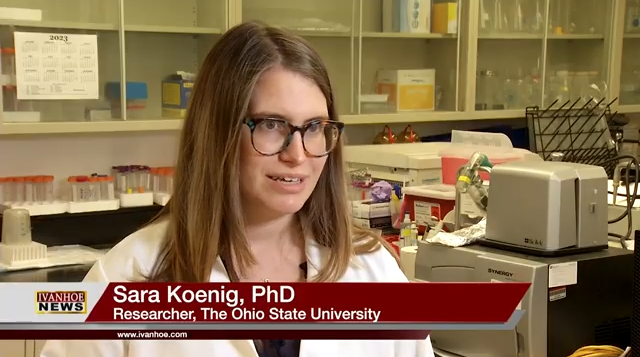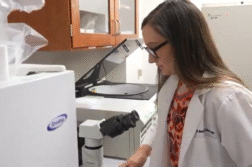The Ohio State University researcher, Sara Koenig, PhD talks about how good cholesterol isn’t always good and can lead to heart disease.
Interview conducted by Ivanhoe Broadcast News in 2022.
We’re talking about cholesterol, and how cholesterol results in atherosclerosis and heart disease. Can you talk about patient Marcus Wright and heart disease being linked to his genes?
KOENIG: Yes, it is very specific. Marcus first came to us when he was in his late 20s. He was training for a marathon, finished a 10-mile run, and immediately went to a local emergency room for what ended up being a heart attack. At that age, someone that is as healthy as running a marathon, that’s extremely unusual. But at the time he didn’t have a family history. Over the course of the next 10 years, his younger brother also developed severe heart disease as did his mother. All three of them ended up having the severe three vessel coronary artery disease. At that point, he had this family history he didn’t originally have. Because it was in his brother and his mother that implied that it was an inherited disease. We did the whole genome sequencing and we identified variants in the gene scar B1, which encodes a receptor for your good cholesterol, your HDL.
Is there a problem with this good cholesterol then, and can you expound that a little further?
KOENIG: Absolutely. I think everyone knows when you get your cholesterol measured, you have your good cholesterol, which is your HDL and your bad cholesterol, which is your LDL. You want your good cholesterol to be high and your bad cholesterol to be low. In the case of Marcus, his bad cholesterol was a little high, but not high enough to have a heart attack when he was 28. But his HDL, his good cholesterol was also high. In the case of him and his brother and his mother, their good cholesterol wasn’t functioning as it was supposed to because of this variant. This specific gene mutation that he has resulted in basically a non-functional good cholesterol. Even though it was there, it wasn’t doing its job.
What does he do then with that knowledge? You were able to tell him where the problem was, does that give his medical team room to work?
KOENIG: Unfortunately, there’s nothing to be done immediately. We can’t fix that gene. What it did do for him is provide a lot of assurance that his children weren’t going to have the same disease he did. He and his brother are the unique cases where they inherited a bad copy of the gene from both of their parents. In his case, he’s only able to pass on one of those copies to each of his children. They might be predisposed to cardiovascular disease, but they won’t see the same severe disease that he did. That was life changing. Then as for the care team, we’re using the information that we learned about his specific gene and his specific variants to try and look for other drugs that we might be able to re-purpose to improve the function of his good cholesterol.
In order to pass this onto his kids would his wife also need to have the same gene variants in order for the kids to have it?
KOENIG: We all have two copies of every gene. Unfortunately, in his case he received a bad copy from both parents. He is going to pass on one of those bad copies to his kid, but they’re only going to inherit one bad copy. They’re not going to inherit two bad copies. They are not going to have that same severe disease that he did.
You and your team are studying in other models here in the lab, what could potentially be down the road? Can you speak to that a little bit?
KOENIG: We were able to obtain a large panel. It’s close to 1,000 drugs that have already been FDA approved with the idea, if there’s a drug on the market that is already being used to treat people, it’s already been approved. It’s shown that it’s safe, it’s shown that it’s effective. Can we repurpose it to help individuals that have good cholesterol that isn’t functioning well? That is what we’re working on now. We have animal models that have the exact same gene mutation that Marcus has. We also have cell culture models, and we’re using both of those models to try and identify specific drugs or specific pathways that we can target to do that.
You did whole genomic sequences? Can you just break that down, what essentially is that for our viewers?
KOENIG: For genomic sequencing, we look at the specific pattern of A, G, C, and T that makes up each of our DNA. The human genome has a set number of genes that are typical. All of us likely have around that number of genes, but we also have millions of different variants within our genome. When we search through an individual’s genome, we look for those variations from what is considered normal.
How did you do the DNA? It wasn’t blood, it was a swab. Can you explain?
KOENIG: We did a blood sample for Marcus. We did a swab for his brother. You can get DNA from a cheek swab or from blood.
What is the long-range goal for you and your team?
KOENIG: The long-range goal for my team is really to understand how good cholesterol can contribute to this cardiovascular disease and atherosclerosis. The field really knows how bad cholesterol is contributing to it and most of the available treatments right now focus on the bad cholesterol pathway. We really want to understand how good cholesterol could be misfunctioning. How we can identify poorly functioning good cholesterol in the population, and then how we can treat it as a supplement to therapies that are already available for individuals with high cholesterol atherosclerosis and coronary artery disease.
END OF INTERVIEW
This information is intended for additional research purposes only. It is not to be used as a prescription or advice from Ivanhoe Broadcast News, Inc. or any medical professional interviewed. Ivanhoe Broadcast News, Inc. assumes no responsibility for the depth or accuracy of physician statements. Procedures or medicines apply to different people and medical factors; always consult your physician on medical matters.
If you would like more information, please contact:
Amy Colgan
Sign up for a free weekly e-mail on Medical Breakthroughs called First to Know by clicking here




